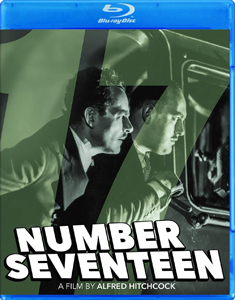With his sixth sound film, “Number Seventeen” (1932, sometimes titled as “Number 17”), Alfred Hitchcock accidentally showcases his skill in action direction and editing. It’s something he ended up being quite good at, although it is overshadowed by his skill in suspense. Ironically, his failure to drum up suspense here is why the action stands out.
Based on a 1925 play, which is clear in the opening couple of acts set in the titular house at midnight, “Number Seventeen” finds a confusing variety of people gathering and hiding their true identities from each other. At least we can be fairly sure of Ben (Leon M. Lion, a Tim Blake Nelson of his day). He’s a quirky homeless man who simply wanted a place to crash.
House party
So many thieves converge on the place that I swear at one point a new one appears in the narrative without introduction. Probably on a rewatch I’d notice his introduction, but even at 66 minutes, I don’t desire a rewatch.

“Number Seventeen” (1932)
Director: Alfred Hitchcock
Writers: Joseph Jefferson Farjeon (play); Alma Reville, Alfred Hitchcock, Rodney Ackland (scenario)
Stars: Leon M. Lion, Anne Grey, John Stuart
Generally, the exact nature of the maguffin does not matter; we simply need to know that everyone wants it. But somehow the valuable necklace is strikingly uninteresting here.
We’re more caught up in the intrigue of the fact that everyone has been invited to the house via special cards with “17” on them. The plotting – with Hitchcock, Alma Reville and Rodney Ackland expanding Joseph Jefferson Farjeon’s play — reminds me of the thriller novels Agatha Christie romped (and sometimes bumbled) through.
I get the sense that writers, not real thieves, are plotting this out. The aim seems to be viewer enjoyment more so than smart villainous strategizing. It’s more confusing than enjoyable, though. I doubt any viewer of “Number Seventeen” could explain to me the big picture of what the thieves’ aims are, or even who the ringleader is.
Films of this type tend to plaster over potential plausibility faults with wild rosters of big-name and/or character actors; I’m thinking of another number-oriented saga, the “Ocean’s 11” yarns. “Number Seventeen” surprisingly hasn’t been remade with a crisper screenplay, but its DNA certainly continued on.
Strangers (to us) on a train
In the final act, Hitchcock for some reason moves everyone to a moving train, and we’re treated to the film’s saving grace: an early example of his skill with action – quite a contrast from a horribly awkward fistfight in the house.
Hitchcock himself would later dabble in train-based hijinks in “The Lady Vanishes,” “Strangers on a Train” and other films. Yet “Number Seventeen” stands as his most prototypical example of future standout train sequences like in “The Great Train Robbery,” “Indiana Jones and the Last Crusade” and multiple “Mission: Impossible” films.

Of course, at times we can see he is using scale models of the train, but generally the action is well staged, well edited and propulsive. Less than a decade into the advent of sound filmmaking, he knows how to use rapid cuts and sound design to enhance the visceral thrills. In this relatively early period of cinema, we truly feel like these people are making their way across the tops and sides of speeding train cars.
Now, as for why they are doing something so dangerous, well, it’s to acquire the maguffin. Or in some cases – if they are secretly a detective – to stop the bad guys from acquiring the maguffin. In “Number Seventeen,” that provides the structure, but not a reason to care. Strictly as Hitchcock homework, there’s enough decent stuff here to make the movie worth a watch – if not a necklace.
RFMC’s Alfred Hitchcock series reviews works by the Master of Suspense, plus remakes and source material. Click here to visit our Hitchcock Zone.

